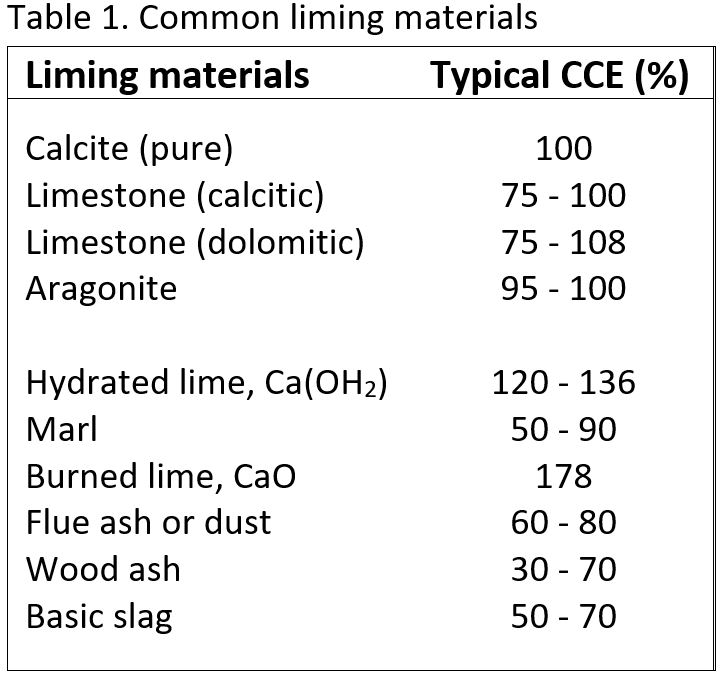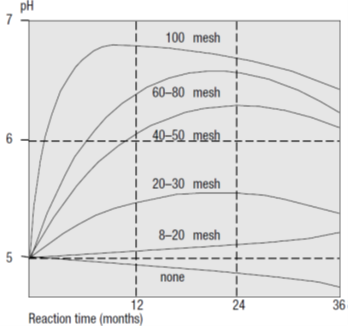
There are a number of options for materials that can be used to raise the pH of acidic soils. There are two key factors that should be used to compare materials: CCE and particle size.
Cheryl Mackowiak, UF/IFAS Soil Scientist, North Florida Research and Education Center – Quincy
–
If your soil pH is too acidic (many crops and forages perform better at a soil pH above 5.5), then you should consider applying a liming material. There are two major parameters to check for an effective liming material:
- Purity (calcium carbonate equivalent, CCE).
- Speed of reaction (particle size distribution)
The CCE standard is set at 100 (pure calcite). In comparison, common ag-lime averages approximately 75 to 100% of pure calcite (CCE = 75 to 100). Therefore, if your product has a CCE of 50, you will need to apply twice as much product to meet your soil report lime recommendation. Table 1 provides CCE estimates of common liming materials that may be available in your area. Use this information as a guide, but request the specific CCE (particularly of alternative liming materials) from supply dealers for final consideration and application calculations.
–
The particle size distribution is also important, because finer particles will react with moisture in the soil faster to affect soil pH. Figure 1 provides some relative rates of reaction of ag-lime particles passing through different mesh sizes. Mesh size is expressed as number of openings per inch; to get more openings per inch the opening must get smaller. Hence larger numbers correspond to finer mesh and smaller particles. For a faster reaction time, you want a greater proportion of particles to pass through 50 mesh (50 openings per inch). In comparison, particles larger than 20 mesh (0.03 inch diameter) will likely provide little to no liming ability. In Florida, size distribution minimums are as follows: at least 90% through 8 mesh, at least 80% through 20 mesh, and at least 50% through 50 mesh.–
When we combine the attributes of CCE and particle size, we call that the effective calcium carbonate equivalent (ECCE) or relative neutralizing value (RNV). If available, this value is the best estimate of liming power for your field. Generally, many states use a wet sieving method to determine percent of material that passes through three or more different sieve sizes to help determine ECCE. In Florida, lime material suppliers must provide CCE and the following: “This product requires __ tons (pounds) to be equal to one ton of standard liming material”. Basically, they make the manufacturer calculate the equivalent application rate for you! Other minimum guarantees include: a maximum of 15% moisture and a “Standard Liming Material” must have a CCE of at least 90%. Other “Liming Materials” not labeled as “Standard” must have at least 75% CCE. A “Calcitic Liming Material” must be comprised of at least 70% calcium carbonate (CaCO3) and the remaining CCE will be from magnesium carbonate (MgCO3). For “Dolomitic Liming Material”, at least 30% will be MgCO3 and remainder as CaCO3. For example, dolomitic limestone in Florida will have a minimum CCE of 70, with 30% MgCO3 and 40% CaCO3. Once again, if the total CCE is at least 90%, it can be labeled as “Standard Calcium-Magnesium Liming Material”.
Some folks want to know if pelletized lime can be used at lower rates than typical ag-lime because it tends to be finely ground. A greater proportion of the pelleted material passed through 100 mesh (prior to being pelletized). Florida regulations require the label to state how much of this material is equivalent to 1 ton of “Standard Liming Material” (i.e., minimum CCE 90%). Upon reviewing the labels of several advertised products, it appears that these materials can typically be applied at a rate approximately 10 to 20% less than “Standard Liming Materials,” or perhaps 30 to 40% less than non-standard liming materials that have a minimum CCE of 75%. However, remember that the finer ground the liming material, the less longevity it may have in the field. The bottom line for Florida farmers comparing liming materials is to have the supplier disclose the CCE and pounds required to meet a “Standard Liming Material” at 1 ton per acre. For home gardens when you are purchasing liming materials in 40 or 50lb bags, check the label yourself to get the best buy for the money.
- 2025 Cool-Season Forage Tour – February 26 - February 14, 2025
- Florida Soils are an Indispensable Natural Resource - January 10, 2025
- Regenerative Agriculture: What it Means to You - June 21, 2024


